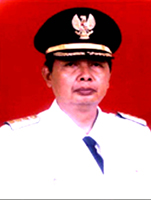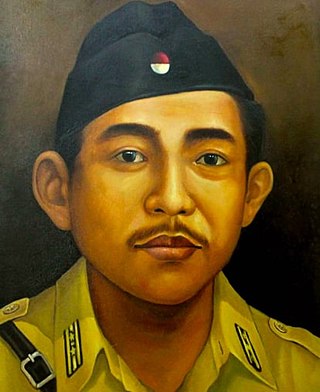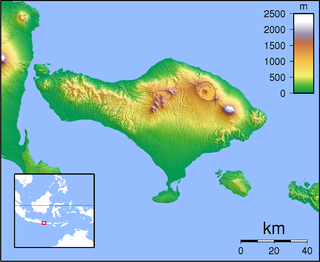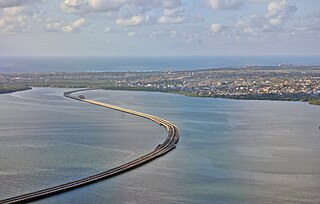
I Gusti Ngurah Made Agung (1876-1906) was the king of Badung, Bali who died in battle during the Dutch intervention in Bali (1906). He was declared a National Hero of Indonesia by President Joko Widodo in 2015. [1]

I Gusti Ngurah Made Agung (1876-1906) was the king of Badung, Bali who died in battle during the Dutch intervention in Bali (1906). He was declared a National Hero of Indonesia by President Joko Widodo in 2015. [1]
I Gusti Ngurah Made Agung was born on April 5, 1876, in Denpasar, Bali and became the seventh king of Badung in 1902. [2] During his reign, he wrote a number of Balinese language works, many of which had anti-colonial themes, including Geguritan Dharma Sasana, Geguritan Niti Raja Sasana, Geguritan Nengah Jimbaran, Kidung Loda, Kakawin Atlas, and Geguritan Hredaya Sastra. [2]
The Dutch used the pretext of a stranded ship flying under the Dutch flag, the Sri Kumala, to step up its aggression against Badung. The ship was stranded Sanur Beach on May 27, 1904, and the Dutch accused the kingdom of pillaging the ship and refusing compensation. [3] This led to the Dutch enforcing a blockade against Badung from November 1904 onwards. [3] During the Dutch intervention in Bali (1906), in September 1906 the Royal Netherlands East Indies Army invaded Bali. After the bombardment of his kingdom on September 20, I Gusti Ngurah Made Agung was forced to react. [2] Despite not having modern weapons, he fatally led his troops against the Dutch in a battle to the death (the Puputan Badung). [2]
In November 2015 he was declared a National Hero of Indonesia by President Joko Widodo. [2]

Anak Agung Gede Ngurah Puspayoga is an Indonesian politician. He was Indonesia's Minister of Cooperatives and Small & Medium Enterprises under President Joko Widodo's Working Cabinet between 2014 and 2019. Previously, he served as the Vice Governor of Bali from 2008 to 2013 and Mayor of Denpasar, Bali's capital city, from 2000 to 2008.
A Balinese name is part of a system of identification used by the Balinese people and in the western parts of the neighboring island of Lombok, Indonesia. A Balinese name will have three parts: a title, a birth order name and a personal name. Balinese people do not use a family name.

Anak Agung Ngurah Oka Ratmadi, commonly known as Cok Rat, was the regent of Badung Regency, Bali, Indonesia from 1999 to 2005, and currently a member of the Regional Representative Council (DPD) from Bali since 2014. He was nominated for the Governor of Bali in 2003, but he withdrew. He is the great-grandson of I Gusti Ngurah Made Agung, a National Hero of Indonesia who fought against the Dutch. He has three children, the second one, AA Krisna Yoga, died on 7 March 2016.

The Klungkung Palace, officially Puri Agung Semarapura, is a historical building complex situated in Semarapura, the capital of the Klungkung Regency (kabupaten) on Bali, Indonesia. The palace (puri) was erected at the end of the 17th century, but largely destroyed during the Dutch colonial conquest in 1908. Today the basic remains of the palace are the court of justice, the Kertha Gosa Pavilion, and the main gate that bears the date Saka 1622. Within the old palace compound is also a floating pavilion, the Bale Kembang. The descendants of the rajas that once ruled Klungkung today live in Puri Agung, a residence to the west of the old palace, which was built after 1929.

Puputan is a Balinese term for a mass ritual suicide in preference to facing the humiliation of surrender. It originally seems to have meant a last desperate attack against a numerically superior enemy. Notable puputans in the history of Bali occurred in 1906 and 1908, when the Balinese were being subjugated by the Dutch.

Colonel I Gusti Ngurah Rai was an Indonesian National Hero who commanded Indonesian forces in Bali against the Dutch during the Indonesian War of Independence. He was killed in the Battle of Margarana.
Ngurah may refer to:

The Dutch intervention in Bali in 1906 was a Dutch military intervention in Bali as part of the Dutch colonial suppression, killing over 1,000 people, most of whom were civilians. It was part of the Dutch campaign for the suppression of most of the Netherlands East-Indies. The campaign killed the Balinese rulers of Badung and their wives and children, as well as destroying the southern Bali kingdoms of Badung and Tabanan and weakening the kingdom of Klungkung. It was the sixth Dutch military intervention in Bali.

The History of Bali covers a period from the Paleolithic to the present, and is characterized by migrations of people and cultures from other parts of Asia. In the 16th century, the history of Bali started to be marked by Western influence with the arrival of Europeans, to become, after a long and difficult colonial period under the Dutch, an example of the preservation of traditional cultures and a key tourist destination.

Dalem Di Made was a king of Bali who may have reigned in the period 1623–1642. He belonged to a dynasty that claimed descent from the Majapahit Empire of Java, and kept residence in Gelgel, close to Bali's south coast.
Anglurah Agung, also known as Gusti Agung Di Made or Gusti Agung Maruti, was a king of Gelgel, the paramount kingdom on Bali, who ruled at a time when the political unity of the island began to break down. This process led to the permanent division of Bali into several minor kingdoms by the late 17th century.

The Dutch intervention in Bali in 1849 was a major Dutch military intervention in Northern and Southern Bali, following two failed interventions, the 1846 intervention and the 1848 intervention. The Dutch used as a pretext Balinese salvage claims over shipwrecks, which were customary to the Balinese, but unacceptable under International law.
Balinese Kshatriya is a Hindu Kshatriya community which exists in the island of Bali in Indonesia. During the second half of the sixth century, Bali had a strong Kshatriya ruling dynasty. The rulers were mostly indigenous Balinese with some Indian blood. These clans mostly belonged to the Nāgavanshi dynasty. However, in due time, these indigenous Kshatriyas became extinct and were replaced by the Javanese Kshatriyas who immigrated to Bali. Most of the Kshatriyas now living in Bali are claimed to be the descendants of the King Dewa Agung, who immigrated to Bali from Java. However, there are also a few other Kshatriya clans who were elevated to the Kshatriya status from the Vaishya varna. All together, Kshatriyas constitute around 4% of the total Balinese Hindu population.

The Dutch intervention in Lombok and Karangasem took place in 1894, and is part of the string of Dutch interventions in and around Bali that led to complete colonization of both Bali and Lombok by the early 20th century.
I Wayan Gobiah was a Balinese teacher and writer. He is best known for Nemoe Karma, a 1931 novel which is considered the first Balinese-language novel.

Bali Mandara Toll Road or Nusa Dua-Ngurah Rai-Benoa Toll Road is a toll road carried by a bridge stretching across the Gulf of Benoa. The 12.7-kilometre (7.9 mi) highway connects the city of Denpasar and South Kuta, Badung Regency, Nusa Dua and Ngurah Rai International Airport. It cost Rp 2.48 Trillion to construct and was intended to prevent traffic jams on the Ngurah Rai Bypass Road, previously the only road connecting areas of Bali on opposite sites of the airport. The Ngurah Rai Bypass Road, a land-based route, could not be widened because of the location of the airport runway; the new toll road was instead constructed over water.
Commissaries general Muhammad Jasin was a National Hero of Indonesia and died on 3 May 2012 in RS Polri Kramat Jati. and he was buried in Taman Makam Pahlawan Kalibata. He received National Hero of Indonesia title, with Bernard Wilhem Lapian, Mas Isman, I Gusti Ngurah Made Agung and Ki Bagus Hadikusumo, by President Joko Widodo on 5 November 2015.
The Battle of Margarana was a battle fought between the Netherlands Indies Civil Administration (NICA) and the recently created, rebelling Ciung Wanara Battalion that occurred in Marga, in Bali Indonesia.
The Paruman Agung was the regional parliament of Bali from 1938 until 1950.